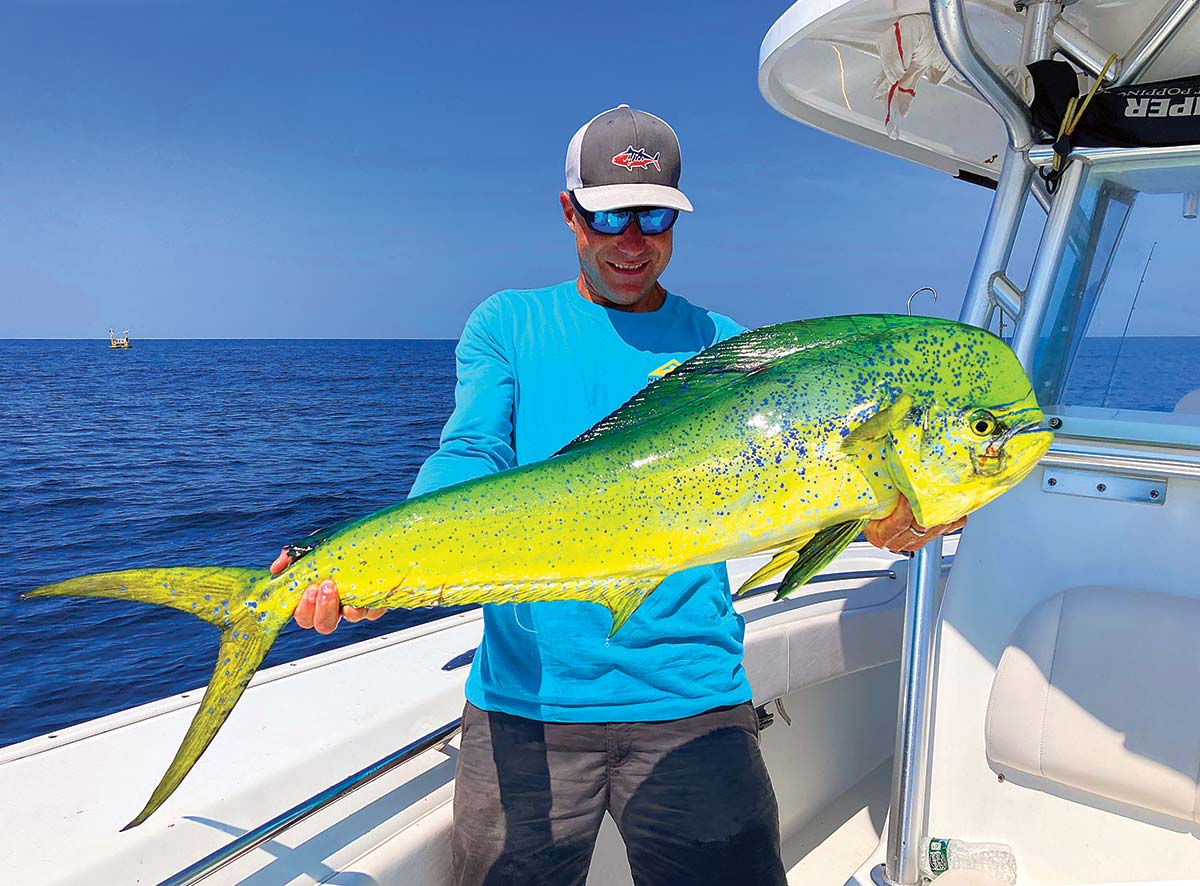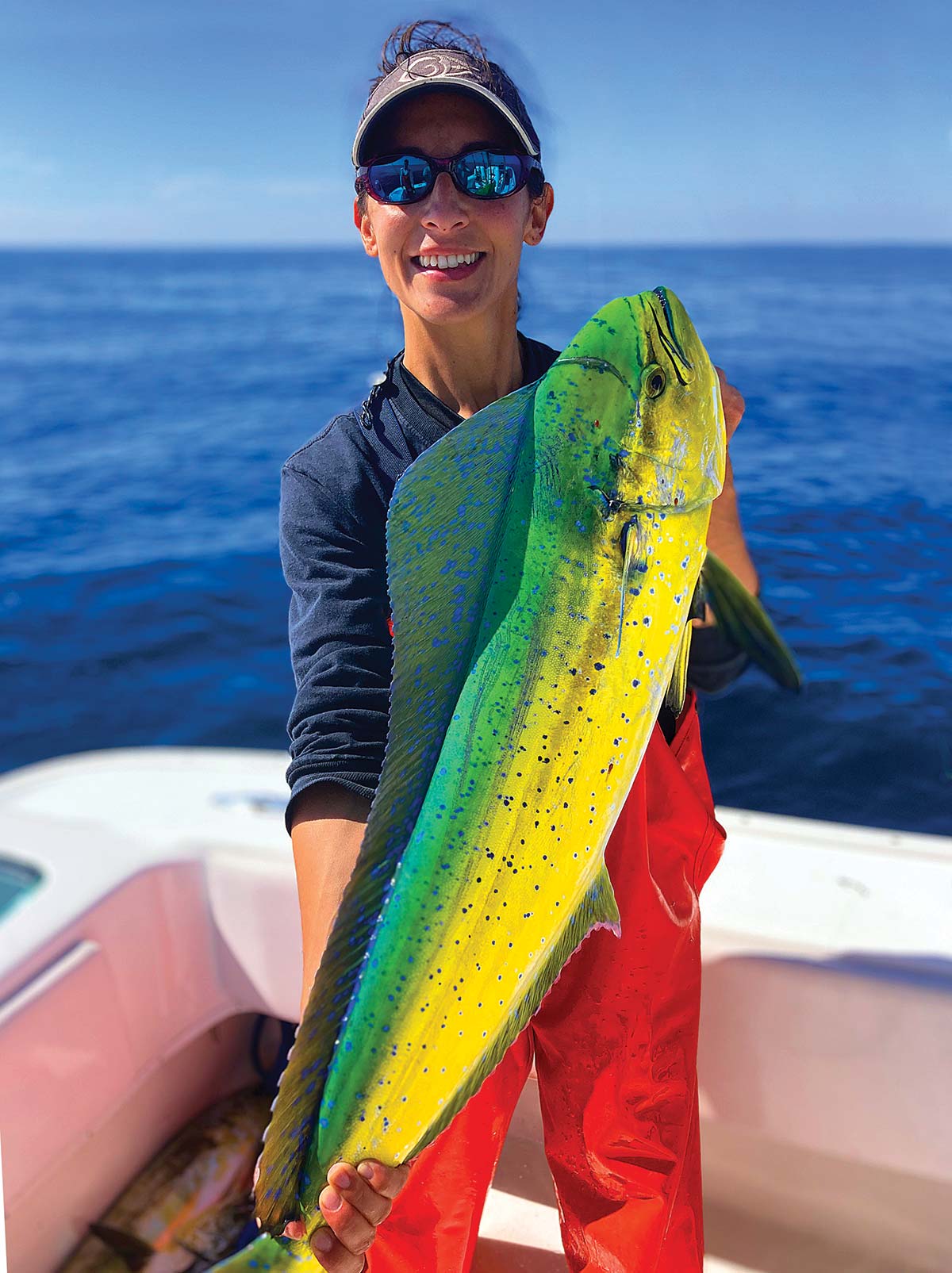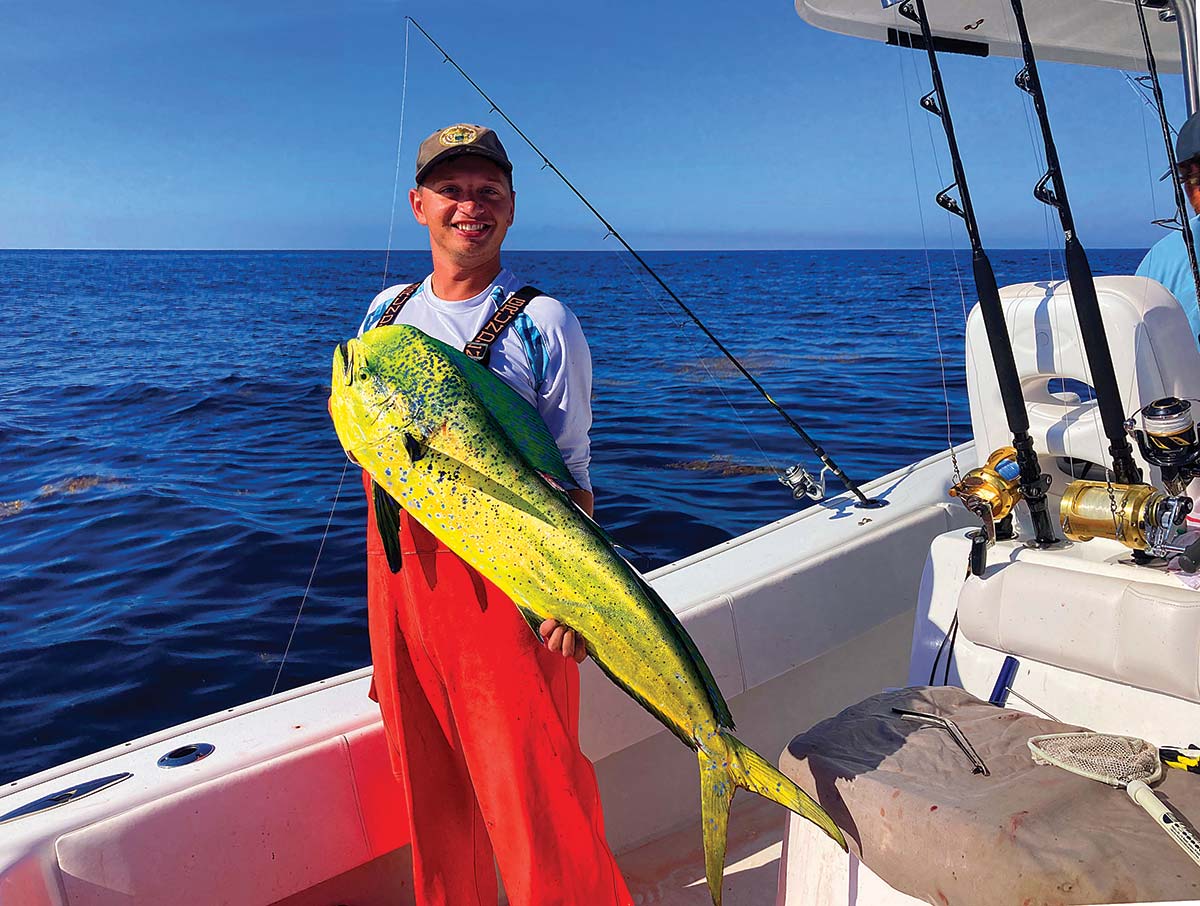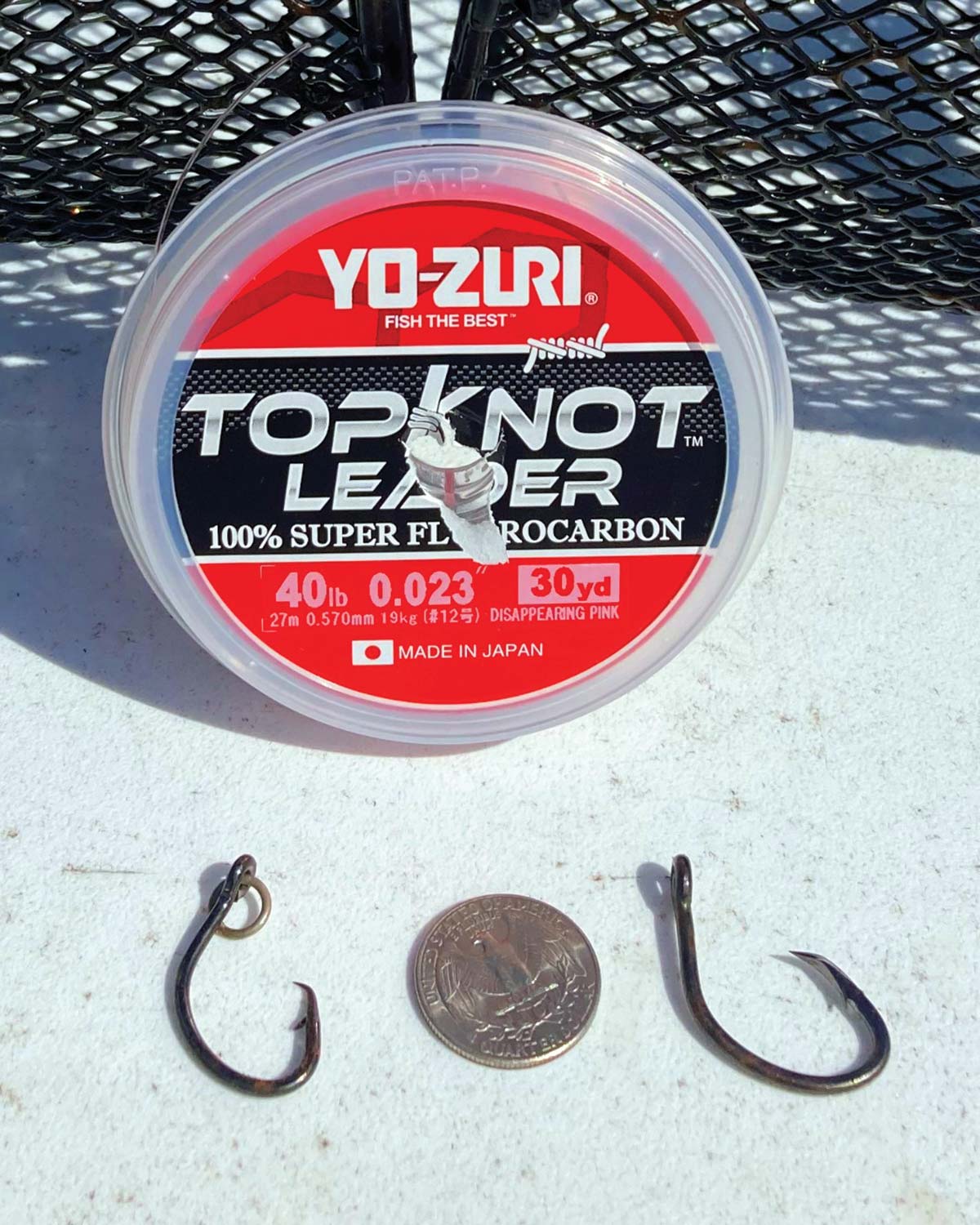
Know what to do for mahi when you come across floating debris in the deep.
Last year was the best mahi mahi season that I have ever seen. My largest came in at 32 pounds! Not only were there incredible amounts of fish around but the sizes of these fish were just as impressive. We probably had 20 fish that were over 15 pounds. A few of those fish were over 23 pounds too. I don’t want to sound obnoxious but a lot of people overestimate the size of a fish that they catch. Especially when it comes to mahi because of its long body shape. A 15- to 20-pound mahi is a really nice size fish for the Northeast. I have written a bunch of mahi articles in the past but I’m still amazed how much I learn about them each season.
Faraway Weeds
I believe last year was such a great season due to the amount of Sargassum weed that was around. These weeds come from an area known as the Sargasso Sea. It’s a region of the Atlantic Ocean bounded by four currents (Gulf Stream, North Atlantic, Canary and Atlantic Equatorial currents). Unlike other seas it has no land boundaries. These four currents deposit marine plants and other floating debris into the Sargasso Sea. Somehow, perhaps a hurricane, caused large amounts of Saragassum weed to end up in the Gulf Stream current. Once in the Gulf Stream current, an eddy may form, bringing them into our Northeast canyons and even further inshore. I could be wrong, I’m not claiming to be a scientist. I just know finding these weeds are a mahi fisherman’s dream. Saragassum weeds are usually full of life and mahi are found under large mats of these weeds. They aren’t there for shade, they are there to feed. Everything from small fish, turtles, crabs and even seahorses are found among these weeds. I love to check the contents of a fish’s stomach to see what they’re feeding on. Last year a few mahi that we cut open actually had Sargassum weed in their stomachs, signifying that they were eating within the weeds.
Oftentimes these weeds are scattered and become a nightmare to troll through. However when these weeds are found in large mats they are great to troll next to and pitch live baits around. They don’t just hold mahi. You may also find wahoo, tuna and marlin underneath them. Before I bore you too much talking about seaweed let’s move on and talk about putting some mahi in the boat.

Going Live
When it comes to mahi fishing, live bait is a must. If you have read some of my previous articles you will know that using live bait is the one constant among my articles. Very rarely have I ever come across a mahi that wouldn’t take a live bait. If you happen to come across a situation where they won’t eat the live stuff I suggest you move on. Snappers (small bluefish), killies, mullet and peanut bunker all make great bait choices for targeting them.
When the mahi first begin to show up in the Northeast canyons in June it’s hard to find live bait. The mullet and snappers aren’t here yet and the bunker are either too big or too small. However there are plenty of killies to be had. Do not discount them. They take very little effort to catch which saves time before heading on those long trips. Just drop down a few killie traps near your dock. Throw a can of cat food or some bread in the trap and in no time you will have plenty of live killies. I love the fact that killies will swim deep too, but if you see them steaking for the surface, it’s a telltale sign that mahi are around.

Wait And Then Bait
When I first come upon mahi under some kind of floating debris I’m never in a rush to get a line in the water. Those fish aren’t going anywhere. First things first, make sure your hook size matches the size of bait you’re going to use, not the size of mahi you hope to catch. If you try to put a 4/0 hook in a killie you are wasting your time. The mahi will most likely notice the huge hook and refuse the bait. On top of that they are now suspicious of everything that is thrown into the water, dead or alive. I’m a huge fan of circle hooks when it comes to mahi. I can pretty much guarantee that you will gut hook every mahi if you use a J-hook. That means you are going to be doing a lot of retying. Plus they won’t stand a chance of surviving if you plan on releasing them. When you come upon something floating (buoys, dock line, hi-flyers, tree branches, 55 gallon drums, etc.) don’t let your crew put any lines in the water just yet. Your crew will be chomping at the bit and perhaps mumble a few unsavory in your direction. Hold your ground! You need to get the fish to trust you. Throw in a bunch of “freebies.” Once the fish start to compete with each other, it’s time to get a hook in the water. It’s important that you keep adding freebies among the baits with hooks in them, as this will keep them feeding while your crew is bailing fish after fish.

Small Hooks, Heavier Leader
When it comes to gear I’d rather talk hooks and leader than rods and reels. When using killies my go to hook is a size 1 circle hook. If you go with a bigger hook the killie will not look natural. When it comes to mullet, snappers and peanut bunker I’m using anything from a 2/0 to a 5/0 circle hook. The 32-pounder I caught last season took 40 minutes to get to the boat. There is no doubt I would have lost that fish if it had swallowed the hook. Even if you use a circle hook there is a chance that it gets swallowed. Mahi have very small teeth. They are used for gripping a prey, not shredding it. However those little teeth will eventually cut your leader. That is why when it comes to leader strength I’m rigging up with 40-pound fluorocarbon. I know a lot of people want to go “stealth” when it comes to leader size, however mahi aren’t as leader shy as tuna. Unlike tuna, mahi jump out of the water. A decent size mahi shaking its head out of water will snap 20-pound leader with ease. Don’t lose that big mahi because you like going “light.”
| THE NAME GAME |
| While the fish in this article are commonly referred to as mahi (Coryphaena hippurus), the proper, full name is mahi-mahi which means “very strong” in the native Hawaiian language. They’re also called the common dolphinfish, or at times, in parts of the Pacific and along the English-speaking coast of South Africa, referred to by its name in Spanish, dorado. Across the ocean, you will hear them called the lampuka on the Mediterranean island of Malta. Additionally, large males are sometimes called bull mahi. |
I have offered a lot of advice over the last few years on how to go about catching mahi. I don’t claim to know everything. In fact I am amazed at how much I continue to learn each time I push off the dock, just to come back with even more info by the day’s end. But I will leave you with a small glimpse into just how much I love to target mahi. Last year there was a great yellowfin tuna bite behind the commercial “draggers.” We got an incredible mid-October day to head deep. To be honest I don’t know if I had ever seen the ocean so nice. It was flat with just a gentle breeze that would last the entire day. By 10 a.m. we were hand feeding yellowfin at the side of the boat. I knew this would probably be our last chance at getting deep so around noon I informed my buddy who was fishing next to us that I was heading south to hit the pots and look for some mahi. I can’t tell you exactly what he said to me but let’s just say he thought I was crazy for leaving. My wife Gina, my buddy JP and I would end up catching more mahi than we ever could have imagined! This decision made us not have an ounce of regret about our decision to leave the yellows for the mahi. If you use Instagram, you can check out additional details from that day by looking up @fishgaak in the search bar.





